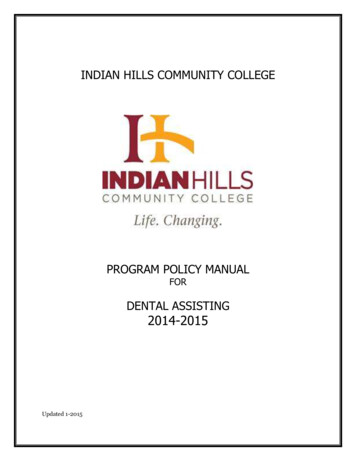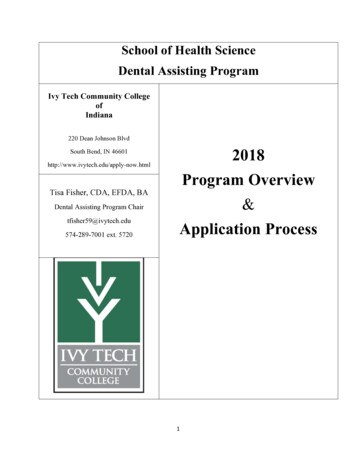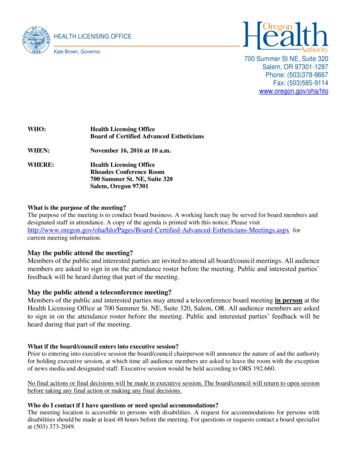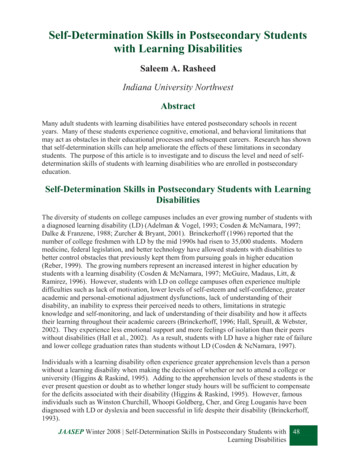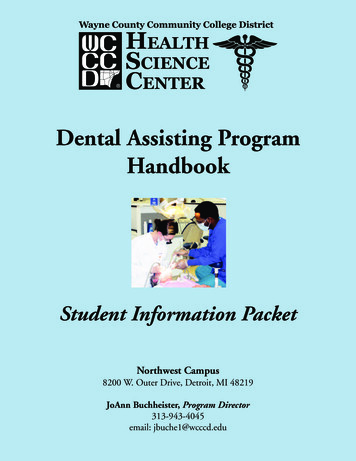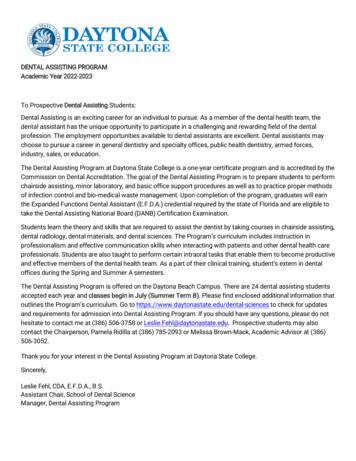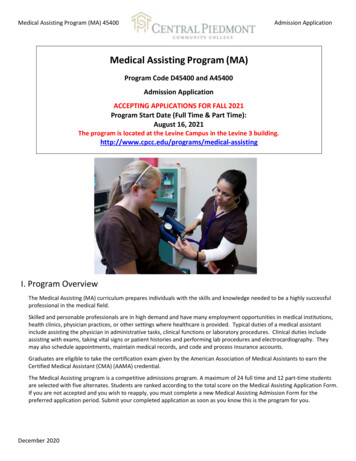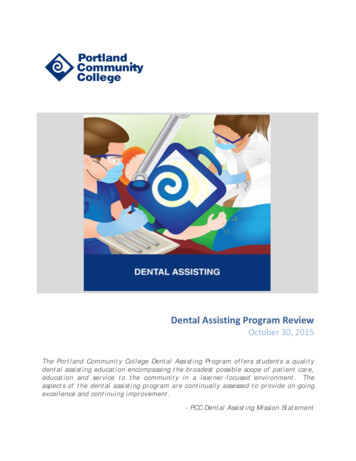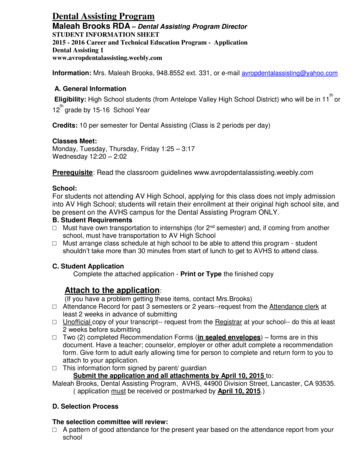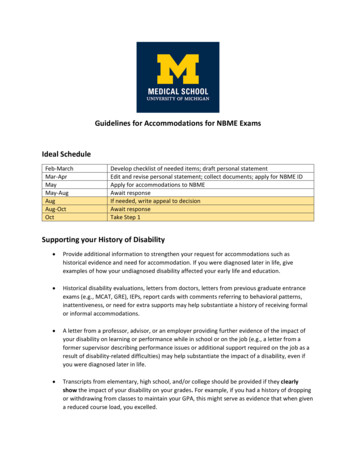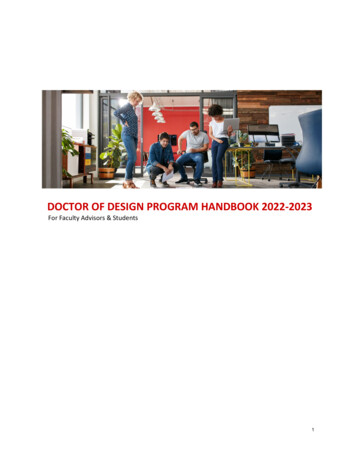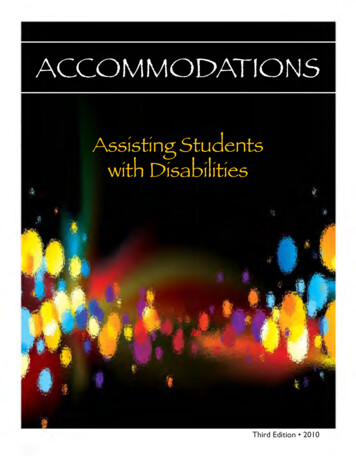
Transcription
ACCOMMODATIONSAssisting Studentswith DisabilitiesThird Edition 2010
This publication was produced through the Bureau of Exceptional Education and StudentServices (BEESS), Division of Public Schools, Florida Department of Education, and is availableonline at http://www.fldoe.org/ese/pub-home.asp. For information on available resources,contact the BEESS Resource and Information Center (BRIC).BRIC website: http://www.fldoe.org/ese/clerhome.aspBureau website: http://www. ldoe.org/ese Telephone:850-245-0475Fax: 850-245-0987Email: BRIC@fldoe.org
ACCOMMODATIONSAssisting Studentswith DAsissiastbiniglitiesStudents with DisabilitiesMarty Beech, Ph.D.Learning Systems InstituteFlorida State UniversityBureau of Exceptional Education and Student ServicesFlorida Department of EducationThird Edition 2010
This document was developed by the Accommodations and Modifications for Studentswith Disabilities Project through the Learning Systems Institute, Florida State University,a special project funded by the State of Florida, Department of Education, Division ofPublic Schools, Bureau of Exceptional Education and Student Services, through federalassistance under the Individuals with Disabilities Education Act (IDEA), Part B.Florida Department of EducationBureau of Exceptional Education and Student ServicesBambi J. Lockman, ChiefCathy Bishop, Administrator, ESE Program Development and ServicesSheryl Sandvoss, Program Specialist, ESE Program Development and ServicesCopyrightState of FloridaDepartment of State2010Authorization for reproduction is hereby granted by the State System of PublicEducation as defined in section 1006.39, Florida Statutes. No authorization is granted fordistribution or reproduction outside the State System of Public Education without priorapproval in writing.
TABLE OF CONTENTSIntroduction:. 1Section One:Accommodations:A Key to Success. 3Federal and State Requirements . 4Online Resources. 6Eligibility for Accommodations . 7Categories of Disabilities. 7Disability under Section 504. 10Selection of Accommodations . 11Accommodations for English Language Learners . 15Impact of Accommodations . 15Decision-Making Guidelines. 17Summary. 18Section Two:Types of Accommodations. 19Presentation Accommodations . 20Specialized Presentation Formats . 21Presentation Supports. 25Response Accommodations . 31Alternate Response Modes. 31Response Supports . 34Setting Accommodations . 40Accessibility . 40Behavior Management . 42Organization of Space and Materials . 43iii
Section Two:Types of Accommodations, cont .Scheduling Accommodations . 44Time Allocation. 44Time Management. 45Unique and Non-allowed Accommodations for FCAT and FCAT 2.0. 46Summary. 47Section Three: Integrating Accommodations with Instruction. 49Identifying Accommodations. 49Planning for the Use of Accommodations . 51Universal Design for Learning . 52Implementing Accommodations. 54Differentiated Instruction. 54Modifying Expected Outcomes. 55Monitoring and Evaluating Accommodations . 57Collaboration and Support . 58Conclusion . 59Appendix: Accommodations: Quick Reference Guide . 61References . 73iv
INTRODUCTIONThis document updates Accommodations: Assisting Students with Disabilities,A Guide for Educators, published by the Florida Department of Education(FDOE) in 2003.This document is written to assist school district personnel and parentswhen making decisions about the use of accommodations by studentswith disabilities in instructional situations.The first section includes information about the importance of providingaccess to the Next Generation Sunshine State Standards for studentswith disabilities. This section also describes legal requirements andeligibility considerations, along with a framework for making decisionsabout accommodations.The second section presents an explanation of four categories ofaccommodations and related student characteristics. As appropriate,accommodations allowed on the Florida Comprehensive AssessmentTest (FCAT), the Florida Comprehensive Assessment Test 2.0 (FCAT2.0,) and the Florida Alternate Assessment (FAA) are noted.The last section deals with implementing and monitoring the effects ofusing accommodations.The Appendix includes a quick reference guide to instructionalaccommodations.1
This page intentionally left blank.
SECTION ONEAccommodations: A Key toSuccessThe mission of the Florida Department of Education is to increase theproficiency of all students within one seamless, efficient system . . .The adoption of the Next Generation Sunshine State Standards is oneof the major steps Florida is taking toward accomplishing its mission ofincreasing the proficiency of all students. The standards establish the corecontent of curricula in Florida. Students in grades K–12 are expected toacquire the knowledge and skills specified in the standards.In Florida, all students with disabilities have the opportunity to worktoward grade-level academic standards. Students with disabilities may useaccommodations during instruction and assessment. Accommodationsmeet the individual student needs and ensure equal access to theacademic content standards (Bureau of Exceptional Education andStudent Services [BEESS], 2006, September).Accommodations are changes that can be made in the way thestudent accesses information and demonstrates performance(Rule 6A-6.03411(1)(a), Florida Administrative Code [F.A.C.]).The accommodations make it possible for students to work aroundthe effect of their disabilities. Accommodations are not the sameas instructional interventions for academics or behavior. They help3
Accommodations: Assisting Students with Disabilitiesstudents access information and show what they know and are ableto do. Students with disabilities who are unable to achieve grade-levelbenchmarks due to a significant cognitive disability may learn alternateachievement standards of the Next Generation Sunshine State Standards,known as Access Points.The FCAT, FCAT 2.0, End-of-Course (EOC)Assessments, and the FAA areimportant components of Florida’s accountability system. These statewideassessments measure how well students have achieved the knowledge andskills required in the academic content standards. In Florida, all studentsattending public schools must participate in the statewide assessmentprogram. Students with disabilities and students who are English languagelearners (ELLs) may have accommodations for statewide assessments.Federal and State RequirementsFlorida’s educational standards and accountability system support therequirements of federal laws regarding participation of students withdisabilities in standards-based instruction and assessment initiatives. TheElementary and Secondary Education Act of 2001 (ESEA), also knownas No Child Left Behind (NCLB), holds states accountable for theachievement of all students.The Individuals with Disabilities Education Act of 2004 (IDEA) governsservices provided to students with disabilities. School districts mustfollow established procedures to identify and evaluate students whoare suspected of having a disability. The individual educational plan (IEP)documents the services required to meet the student’s needs. Bothlaws (ESEA and IDEA) require students with disabilities to participate instatewide assessments with accommodations, where necessary.Section 504 of the Rehabilitation Act of 1973 is a federal law thatprotects the rights of students with disabilities enrolled in public schoolsreceiving federal funds. Section 504 requires school districts to providea free appropriate public education (FAPE) to each qualified studentwith a disability. Students with disabilities may have accommodations forinstruction and assessment.4
Section One: Accommodations: A Key to SuccessSection 1003.428 of the Florida Statutes (F.S.) establishes therequirements for graduation with a standard diploma. This law also statesthat exceptional students have the opportunity to meet the graduationrequirements for a standard diploma through enrollment in basic courseswith accommodations based on individual needs. The law provides fortest accommodations and identifies criteria for waiver of FCAT, FCAT2.0, and EOC Assessment requirements for high school graduation.Students with disabilities who have an IEP may also be eligible for aspecial exemption from the graduation test requirement in extraordinarycircumstances.A list of relevant Florida Statutes and rules in the Florida AdministrativeCode follows:Students with DisabilitiesRule 6A-6.03028, F.A.C.Provision of Free Appropriate PublicEducation (FAPE) and Development ofIndividual Educational Plans for Studentswith DisabilitiesRule 6A-6.0331, F.A.C.General Education Intervention Procedures,Identification, Evaluation, Reevaluationand the Initial Provision of ExceptionalEducationRule 6A-19.001, F.A.C.Scope, Coverage and DefinitionsStandardsSection 1003.41, F.S.Sunshine State StandardsSection 1003.428, F.S.General requirements for high schoolgraduation; revisedRule 6A-1.09401, F.A.C.Student Performance Standards5
Accommodations: Assisting Students with DisabilitiesAssessment and AccommodationsSection 1008.22(3)(c)6, F.S. Student assessment program for publicschoolsRule 6A-1.09422, F.A.C.Florida Comprehensive Assessment Test andEnd-of-Course Assessment RequirementsRule 6A-1.0943, F.A.C.Statewide Assessment for Students withDisabilitiesRule 6A-1.09431, F.A.C.Procedures for Special Exemption fromGraduation Test Requirements for Studentswith Disabilities Seeking a Standard HighSchool DiplomaRule 6A-6.09091, F.A.C.Accommodations of the StatewideAssessment Program Instruments andProcedures for English Language LearnersOnline ResourcesThe following list provides links to FDOE websites to inform educators,parents, and the general public about the educational standards, statewidetesting requirements, accommodations for students with disabilities, andFlorida Statutes and State Board of Education Rules.Next Generation Sunshine State StandardsWebsite: http://www.floridastandards.org/index.aspxFlorida Comprehensive Assessment TestWebsite: http://fcat.fldoe.org/Florida Alternate AssessmentWebsite: ations InformationWebsite: http://www.fldoe.org/ese/fcatasd.asp6
Section One: Accommodations: A Key to SuccessFlorida StatutesWebsite: http://www.leg.state.fl.us/Statutes/State Board of Education Rules (Florida Administrative Code)Website: http://www.fldoe.org/rules/Eligibility for AccommodationsStudents are eligible for accommodations after they have been properlyevaluated and determined eligible for services. The IEP team or teamthat determines the student’s needs and develops the plan requiredunder Section 504 of the Rehabilitation Act considers the current levelof academic achievement and functional performance as well as theeffect of the disability. The team determines what accommodations arenecessary. The team documents all determinations regarding the needfor accommodations in an IEP or Section 504 plan. Evidence must showthat the student has been found eligible for services through one of theseplans.Categories of DisabilitiesA brief description of the categories of disabilities used in Florida followson the next four pages. A student who is eligible for exceptional studenteducation (ESE) services is identified by one or more of these categories.These brief descriptions clarify terminology and acronyms.Specific Learning Disabilities (SLD)A specific learning disability is a disorder in one or more of the basiclearning processes involved in understanding or in using spoken orwritten language. Students may have significant difficulties affecting theirability to listen, speak, read, write, spell, or do mathematics.(Rule 6A-6.03018, F.A.C.)Intellectual Disabilities (InD)Students with an intellectual disability have significantly below averagegeneral intellectual and adaptive functioning that is manifested duringthe developmental period (birth through 18 years).These students have7
Accommodations: Assisting Students with Disabilitiessignificant delays in academic skills.(Rule 6A-6.03011, F.A.C.)Emotional/Behavioral Disabilities (E/BD)Students with persistent and consistent emotional or behavioralresponses that adversely affect performance in the educationalenvironment that cannot be attributed to age, culture, gender, orethnicity.(Rule 6A-6.03016, F.A.C.)Deaf or Hard-of-Hearing (DHH)Students with substantial hearing impairments that affect processing oflinguistic information are classified as deaf or hard-of-hearing. Studentsmay use sign language or total communication. Individual studentsmay need assistive technology, such as amplifiers, or use hearing aids.Students who are deaf or hard-of-hearing often have difficulties withreading, writing, and communication skills that are related to their hearingloss.(Rule 6A-6.03013, F.A.C.)Visually Impaired (VI)Students who are blind or visually impaired have a significant loss of useof vision. Students may use braille for reading and writing or assistivetechnology to help them obtain information.(Rule 6A-6.03014, F.A.C.)Dual Sensory Impaired (DSI)Students who have dual sensory impairments affecting both vision andhearing, or who have a degenerative condition that will lead to such animpairment, are classified as dual sensory impaired. This combinationcauses a serious impairment in the ability to acquire information,communicate, or function within the environment.(Rule 6A-6.03022, F.A.C.)8
Section One: Accommodations: A Key to SuccessOrthopedic Impairment (OI)Students with orthopedic impairments have a severe skeletal, muscular,or neuromuscular impairment. Impairments may result from congenitalanomalies, such as spina bifida, or other causes, such as cerebral palsy oramputation.(Rule 6A-6.030151, F.A.C.)Other Health Impairment (OHI)Students with other health impairment have limited strength, vitality,or alertness due to chronic or acute health problems, such as asthma,attention deficit disorder or attention deficit hyperactivity disorder, andTourette syndrome. Other types of health problems include diabetes,epilepsy, heart condition, hemophilia, lead poisoning, leukemia, nephritis,rheumatic fever, sickle cell anemia, and acquired brain injury.(Rule 6A-6.030152, F.A.C.)Traumatic Brain Injury (TBI)Students with traumatic brain injury have an acquired injury to the braincaused by an external physical force resulting in total or partial functionaldisability or psychosocial impairment, or both, that adversely affectseducational performance. The term applies to mild, moderate, or severeinjuries resulting in impairments in areas such as cognition; language;memory; attention; reasoning; abstract thinking; judgment; problem solving;sensory, perceptual, and motor abilities; psychosocial behavior; physicalfunctions; information processing; or speech.(Rule 6A-6.030153. F.A.C.)Speech Impairment (SI)Students with speech impairments have problems articulating sounds andwords, using fluent speech, or have significant atypical voice characteristicsthat adversely affect their performance in the educational environment.(Rule 6A-6.03012, F.A.C.)9
Accommodations: Assisting Students with DisabilitiesLanguage Impairment (LI)Students with language impairments have difficulty with the soundsystems of language (phonology), the structure of words (morphology),the meaning of words (semantics), the relationship of words insentences (syntax), or the functional use of language for communication(pragmatics). The student may have significant difficulties in listening, oralexpression, social interactions, reading, writing, or spelling.(Rule 6A-6.030121, F.A.C.)Autism Spectrum Disorder (ASD)Autism spectrum disorder includes a range of pervasive developmentaldisorders that adversely affects a student’s functioning. Students withautism spectrum disorder have an uneven developmental profile anda pattern of impairments in social interaction and communication andthe presence of restricted, repetitive, and/or stereotyped patterns ofbehavior, interests, or activities. These characteristics range from mild tosevere and may manifest in a variety of combinations. Autism spectrumdisorder may include autistic disorder, pervasive developmental disordernot otherwise specified, Asperger disorder, or other related pervasivedevelopmental disorders.(Rule 6A-6.03023, F.A.C.)Developmentally Delayed, Ages Three through Five YearsA child may be developmentally delayed in one or more areas ofdevelopment: adaptive or self-help, cognitive, communication, social oremotional, and physical.(Rule 6A.6-03027, F.A.C.)Disability under Section 504Under Section 504 of the Rehabilitation Act of 1973, a disabled individualis defined as any person who has a physical or mental impairment thatsubstantially limits one or more major life activities, has a record of suchan impairment, or is regarded as having such an impairment. Major lifeactivities include caring for oneself, performing manual tasks, walking,seeing, hearing, speaking, breathing, learning, and working (Rule 6A-19.001,F.A.C.).10
Section One: Accommodations: A Key to SuccessA careful analysis is required to determine if the student has animpairment or condition that is severe enough to limit a major lifeactivity and whether the student is qualified to receive aids, services, oraccommodations for instruction and assessment, including the FCAT,FCAT 2.0, EOC Assessments, or FAA. Students with a temporarydisability, such as a broken arm, may require accommodations for a limitedtime. A Section 504 plan may be developed for the student to accessaccommodations. The student must use the accommodation regularly inthe instructional setting. For example, the student with the broken armwill need an accommodation for writing in classroom activities as well asfor the FCAT (BEESS, 2005).Selection of AccommodationsThrough the IEP or Section 504 planning process, a team of professionals,family members, and the student makes decisions about whichaccommodations the student needs for instruction and for state anddistrict testing programs. The teams consider the student’s learning andbehavior characteristics. The student’s disability category alone doesnot determine whether an accommodation is needed or what type ofaccommodation should be used (Elliott & Thurlow, 2000; Fletcher etal., 2006). The team uses information from comprehensive evaluationprocedures, such as formative assessments, individual diagnosticassessments, observation data, annual assessments, or functionalbehavioral assessments, to make determinations about accommodations(Zabala, 2005, April 29). Examples of learning and behaviorcharacteristics that may result from a disability include: Difficulty attending to complex directions and information Difficulty retaining information Need for additional time when reading braille materials Noncompliant behaviors in large group situations Inability to use regular print to obtain information Difficulty organizing information when writing11
Accommodations: Assisting Students with DisabilitiesMany teams use a process to gather information in a systematic mannerto guide decisions about services and supports for students withdisabilities. The SETT Framework is a planning tool that considers theStudent, the Environment, the Tasks, and the Tools (SETT).The frameworkhelps the members of the team gather information and explore issuesacross a comprehensive set of factors. They use this information todetermine what accommodations and services may be needed. The SETTFramework was originally developed to support the selection of assistivetechnology. The Tools component now includes assistive technologydevices, services, strategies, accommodations, or modifications (TexasAssistive Technology Network, n.d.; Zabala, 2005, April 29).The SETT Framework supports the selection of an appropriate systemof Tools based on the needs of the Student, the typical Environmentsin which the student must function, and the student’s required Tasksthat lead to successful completion of the educational program. Thefull exploration of these factors leads to better decisions by the team(Zabala, 2005,April 29). The members of the planning team collectinformation from many sources to understand the strengths, skills, andchallenges the student possesses, the nature of the environments, andthe necessary tasks. The SETT Framework is not only useful in the initialphases of decision making, but also in guiding ongoing decisions about theeffectiveness of the tools and services (Bowser, Korsten, & Zabala, 2004,Dec./2005, Dec.).The planning team uses questions like the ones on the followingtwo pages to address each of the four key components of the SETTFramework: Student Environment Tasks Tools12
Section One: Accommodations: A Key to SuccessThe SETT FrameworkComponent OneThe Student: Learner Attributes and Abilities What does the student need to be able to do that is now difficult orimpossible to do independently? What are the student’s special needs related to the area of concern? What are the student’s strengths and current abilities? What are the student’s desires and expectations?Component TwoThe Environments: Physical, Technical, and PersonalConditions What materials and equipment are currently available in theenvironment? What is the physical arrangement? Are there special concerns? What is the instructional arrangement? Are changes likely? What supports and resources are available to the student and staff? What are the attitudes and expectations of staff, family, and others? What are the specific issues regarding access to technology, physicalenvironment, and instructional activities?13
Accommodations: Assisting Students with DisabilitiesThe SETT Framework, cont.Component ThreeThe Tasks: What the Learner Must Do What naturally occurring activities take place in the instructionalenvironment? What instruction and assessment activities support the student’scurricular goals? What are the critical elements of the activities? How might the activities be adapted to accommodate the student’sspecial needs? How might technology or other strategies be used to support thestudent’s active engagement in those activities?Component FourThe Tools: What Helps the Learner to Achieve What no-tech, low-tech, and high-tech tools should be consideredwhen developing an instructional system for this student? How might these tools be tried out with the student in the typicalenvironments in which they will be used? What differentiated instructional strategies might be used toincrease student performance? What other accommodations, services, and supports does thestudent need to be actively involved and make progress in theeducational program? Does the student have a significant cognitive disability and needcurriculum modifications (access points)?14
Section One: Accommodations: A Key to SuccessWhen considering accommodations, it is important to obtain input fromeveryone involved—including the parents, ESE staff, and teachers whowill be responsible for delivering the accommodations. The team shouldalso include the student when making decisions about accommodations.The student can provide important insights into accommodations thatare both acceptable and needed. If a student refuses to use a particularaccommodation because it makes him or her look different from peers,the team should consider other options (Thompson, 2005).It is important to measure the effect of the accommodations to verifythe student’s need. Data collected before and after the implementationof the accommodation can show whether the accommodation improvesstudent performance. The IEP or Section 504 planning team should alsobase their decision for continuation of the accommodation on studentdata.Accommodations for English Language LearnersSome students with disabilities are English Language Learners (ELL).The team should consider the student’s current level of Englishlanguage proficiency and the progress the student has made inattaining proficiency when making decisions about accommodations.Students with disabilities who are ELLs currently receiving services inaccordance with an approved district ELL plan may have approved ELLaccommodations on the FCAT and FAA. Many of these accommodationsare similar to those allowed for students with disabilities. Theaccommodations for an ELL student also include limited assistance in thestudent’s heritage language (Rule 6A–6.09091, F.A.C.).Impact of AccommodationsAccommodations do not reduce learning expectations. When a changein the instruction or assessment activity lowers the expectations forstudent learning, it is considered a modification. The phrase curriculummodification is sometimes used to emphasize the impact on learningexpectations. For example, an elementary student who learns how tospell five words each week instead of the 25 words assigned to his peers15
Accommodations: Assisting Students with Disabilitieshas modified expectations for learning. The outcomes for learning aresubstantially reduced. Examples of curriculum modifications include: Requiring less content, such as fewer objectives, shorter lessons,or a smaller number of vocabulary words Limiting assignments and assessments to the easiest problemsTask adaptations reduce the length or complexity of the practiceor test items and make assignments or test items more accessible. Ingeneral, teachers should only use task adaptations in the initial stages ofinstruction and then fade them so that the student has the opportunityto learn the concept or skill at the required level of proficiency. Taskadaptations are considered accommodations because they are temporaryand they do not reduce learning expectations. Examples of taskadaptations include: Making assignments or assessments less complex, such as bycrossing out one of the options on a multiple-choice question sothat a student only has to pick from three options instead of four Providing hints or clues to correct responses on assignments andtests, such as the page number in the book where the answer tothe question can be foundChanging the learning expectations during instruction or assessments mayhave the unintended consequence of reducing the student’s opportunityto learn critical content. This may put the student at risk for not beingable to meet graduation requirements for a diploma. Here are questionsto think about when considering going beyond accommodations andmodifying a student’s learning expectations (Thompson, 2005).1.What are the academic content standards for students at thisparticular grade level?2.Are there grade-level benchmarks that a student will not beexpected to learn?3.How will these modifications in expectations affect a student’sperformance on the state assessments?16
Section One: Accommodations: A Key to Success4.How will these modifications affect a student’s ability toparticipate in the general education curriculum in the future?Will the student fall farther and farther behind due to missedoppor
End-of-Course Assessment Requirements Rule 6A-1.0943, F.A.C. Statewide Assessment for Students with Disabilities Rule 6A-1.09431, F.A.C. Procedures for Special Exemption from Graduation Test Requirements for Students with Disabilities Seeking a Standard High School Diploma Rule 6A-6.09091, F.A.C. Accommodations of the Statewide
